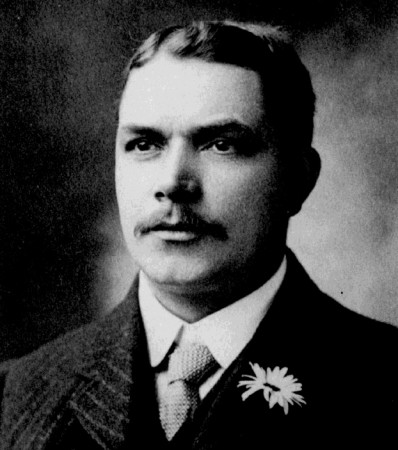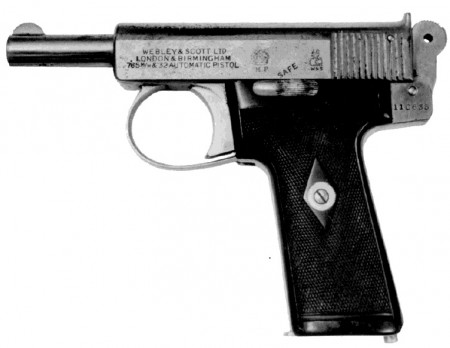
William John Whiting is not a name known to most gun collectors today, because the guns he spent a lifetime working on were never marked with his name, but rather with the name of Webley & Scott. Whiting was born in the industrial coal country of England, specifically a town called Darlaston located about 8 miles northwest of Birmingham. Of course, anyone loosely familiar with British firearms will recognize that Birmingham was a center of arms production for great many years, thanks to its renowned coal and steel production and concentration of craftsmen. Whiting was born the eldest son of William Flint Whiting and Hannah Wiles, on September 13th, 1864 (naming the first son after the father was something of a tradition). As a child, Whiting attended school at the St. Lawrence church, and form a very early age he became interested in following in his father’s footsteps.
The elder William Flint Whiting (who was in his early twenties when William John was born) was employed as a gun lock filer, and he taught Whiting the basics of the gunsmithing trade. By the time Whiting was 9 years of age, he was relatively proficient with a file, and this interest in gunmaking would stay with him throughout his life. His father provided him with old or broken firearms to repair, allowing him to develop an understanding of how the mechanisms worked and how to manipulate them.
In 1873, Whiting’s father was hired on by the firm of Webley & Son in Birmingham, and the family moved to the northern outskirts of that city (well, that was on the northern outskirts at the time). After a few years in another church school (where he excelled, and the headmaster encouraged pupils to develop an interest in technology), Whiting was offered a job at Webley, working alongside his father and the company’s expert gunsmiths. Whilliam John by this time has three brothers and three sisters, and none of his brothers showed any particular interest in guns the way he did. The Webley firm was quite interested in grooming dedicated young men into becoming loyal and expert workers, and Whiting was formally Indentured as an apprentice on his 16th birthday in 1881 – a commitment that would last 5 years.
By the end of that term – and his 21st birthday – Whiting was an acknowledged Tool Maker at Webley & Son, and applied for his first British patent that very year, in 1886. The patent was for a bushing that would prevent black powder residue from getting into the space between a revolver cylinder and the axis pin it rotated on. Around this same time, Webley perfected their hinge-framed revolver, allowing simultaneous ejection of the whole cylinder full of empty cases, and received the first of many major government contracts. Business was good at Webley, and William John Whiting would have his fortunes tied to the company for many years to come.
In 1888 he began his own family by marrying Harriette May Busst, daughter of another gunsmith. Their first child was born late that year, and (in the family tradition) named William James Whiting. At this time he was experimenting with new pistol designs at Webley, starting with a concealed-hammer revolver which was patented with his co-designer John Carter in 1888.
Whiting’s star continued to rise at Webley, with his promotion to Workshop Foreman at the age of 25 and then Works Manager at age 28, upon the unexpected illness and death of his father, who had previously held the position. By this time Whiting and Harriette had four children, and he was about to really come into his element professionally. In 1896, Colonel George Fosbery approached the Webley firm looking for a manufacturer for his automatic revolver. For the next several years Whiting worked to help refine the design into its 1901 production model. Self-loading pistols were looking like the wave of the future, and Webley thought the Fosbery design would be an ideal way to capitalize on that trend while still exploiting their expertise in revolver manufacture.
In 1903, a number of elements changed in Whiting’s life. The end of the Boer Wars, combined with new British restrictions on civilian pistol ownership left Birmingham in general and Webley in particular in tough financial straits. Sales of Webley-Fosbery automatic revolvers, while certainly profitable, were not a replacement for the military contracts of years past. Whiting was offered (and accepted) a position on Webley’s Board of Directors, and dove into design of a true self-loading pistol for British military use – which required use of the rimmed .455 cartridge. While this work would not bear fruit for more than a decade in it’s original application, Whiting’s adaptation and conversion of his basic design to .32 and .25 cartridges would prove to be the financial thread that kept Webley & Scott alive until WWI caused a resurgence in large military orders. Ironically, the sudden demand for the standard military model revolvers would largely force the abandonment of self-loader development, as the military lost interest in unproven new designs and the company no longer had the excess capacity to spare.

Before the outbreak of the war, though, Whiting found the height of his career. His .32 automatic found widespread acceptance, including being chosen as the standard sidearm for the London Metropolitan Police. Whiting undertook several extended overseas trips to promote his pistols, with destinations in the United States, France, Bulgaria, Russia, Norway and elsewhere. His six children (three girls and three boys) reached adulthood during this time, and two of his sons joined him at Webley & Scott (William James as an Engineering Draftsman and the artistic Thomas as an Engraver).
The years of the Great War took a toll on Whiting, ultimately leading to his retirement. Management of the factory became a huge responsibility with the massive volume of wartime production, and his sons Arthur and Thomas left to join the Army (William James was by that time Works Manager for the plant). Thomas was killed in action in 1915 at the Somme, and Arthur wounded there in July of 1916. After recovering from his wounds, Arthur returned to the lines as a commissioned 2nd Lieutenant and was killed in action himself in 1918. The loss of his two sons had a profound impact on Whiting, and he never really recovered from it. Much of hHis passion and enthusiasm at Webley drained from him, and the postwar economic depression didn’t help things. The 1920 Firearms Act, further restricting commercial sale of Webley’s products, was the last straw, and he retired from his position at Webley & Scott on July 6th, 1920 at the age of 57.
Whiting maintained an interest in the gunmaking industry after his retirement, taking enjoyment in helping and advising other gunsmiths on technical questions. He ultimately held a total of 34 patents and while not wealthy, he was able to live a quite comfortable life. When not staying abreast of developments in the gun industry, he spent his retirement years tending to his terrier Prince and a garden of dahlias. A placid and enjoyable life – although perhaps too much so. After his retirement he gained quite a lot of weight – he had been a strong and fit man at nearly 6 feet and 190 pounds, but after a few years or retirement his weight had grown to more than 250 pounds. He developed diabetes without recognizing it, and dizzy spells culminated in his collapse outside his home in early 1924. He fell into a coma, and died on February 9th, 1924 at the age of 59.
Despite his relatively young passing, Whiting enjoyed a fulfilling and happy life. He was able to follow his passion for gunmaking and design and enjoy a mutually very beneficial 40-year relationship with the Webley company. He never became truly wealthy, but real wealth leads to misery as often as happiness, and Whiting never found himself in financial distress with the income from his position and royalties from his many patents. His children were raised well and became successful themselves, at least until Thomas and Arthur fell victim to the ravages of war. Whiting may not have become a household name, but he never looked for fame, and he will remain known to the cadre of collectors and shooters who will continue to enjoy his pistols for many years to come.
Biorgraphy: Bruce, Gordon. Webley & Scott Automatic Pistols. Verlag Stocker-Schmidt, Zurich, 1992.

I know it’s kind of a weird request but is there a photo ailable of his wife and possibly his kids. Also I have to ask the same question about colonel fosbery. I’m doing a lot of in-depth research on the Webley fosbery and could really use photos of their families.
I too have completed this school, I believe many great people have gone through this school, I can also say that as a college student of history I did some writing with the help of this source browse this site from which I understood that The Young Women of Malolos even I had to suffer from the men and other dangers in the family, unfortunately when I was younger I didn’t know this or maybe I considered this as normal, but now when I look back I am amazed how we lived with this. Besides this it should be noted that William John really is a historical personality and I will never forget him.